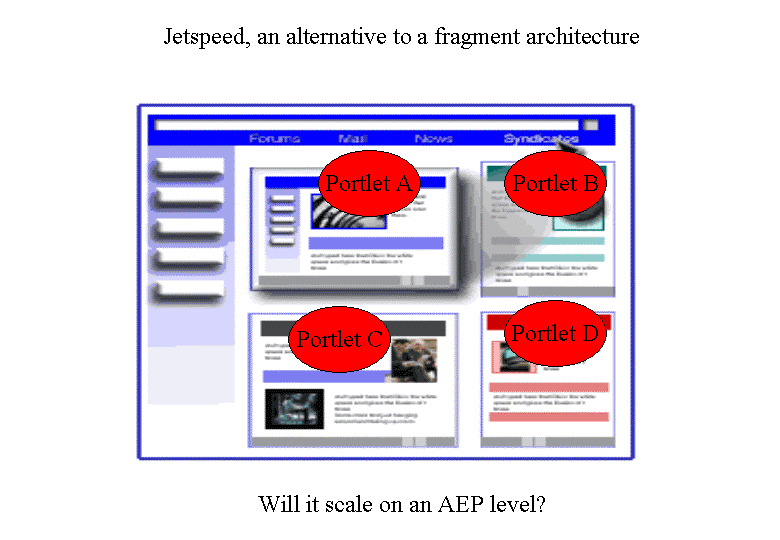So far we have learned the following deficiencies of our model 2 architecture:
"Portlets" were designed to better represent the aggregation of information within a portal page. The next chapter shows that "Portlets" are still somehow vague – are they applications or information? What kind of user experience and degree of information integration do they provide? What are the essential differences to our handler based approach? And finally: are portlets enough?
At first glance portlets seem to represent pretty much the same "boxed" portal page concept as our handlers above. An independent piece of screen real-estate is represented by an individual portlet.
The following text from IBM gives (a lot) more definitions. I have highlighted the most important bits: http://www-4.ibm.com/software/webservers/portal/portlet.html.
What is a Portlet?
"Portlets are the visible active components end users see within their portal pages. Similar to a window in a PC desktop, each portlet owns a portion of the browser or PDA screen where it displays results. Portlets can be as simple as your email or as complex as a sales forecast from a CRM application.
From a user's view, a portlet is a content channel or application to which a user subscribes, adds to their personal portal page, and configures to show personalized content.
From a content provider's view, a portlet is a means to make available their content
From a portal administrator's view, a portlet is a content container that can be registered with the portal, so that users may subscribe to it.
From a portal's point of view, a portlet is a component rendered into one of its pages.
From a technical point of view, a portlet is a piece of code that runs on a portal server and provides content to be embedded into portal pages. In the simplest terms, a portlet is a Java servlet that operates inside a portal.
Portlets are often small portions of applications. However, portlets do not replace an application's numerous displays and transactions. Instead, a portlet is often used for occasional access to application data or for high profile information that needs to be displayed next to crucial information from other applications. In some cases, this is like an executive information system or a balanced scorecard key performance indicators display. In other cases, it may simply be a productivity enhancement where a user can have all the tools and information needed to quickly access multiple applications, documents, and results. For example, a procurement analyst may want to see online vendor product catalogs with prices side by side with current inventory levels from the ERP system, and this next to a business intelligence analysis of item usage for the last 18 months. In any case, a portlet provides a real time display of vital information based on the users preferences.
Portlets can be built by the Information technology department, systems integrators, independent software vendors, and of course, IBM. Once a portlet is developed and tested, it is stored into the portlet catalog. By browsing the portlet catalog, an end user can then select a portlet and place it into one of their own portal pages."
To summarize, a portlet can be:
The definition mixes the results of processing (content) with the means of processing (code, application, container). The difference is quite important: I cannot cache the code but I can cache results!
The main differences to the handler approach:
Portlets seem to be the proper mechanism to create "Windows" or yahoo style portal pages combining independent pieces of information or applications for convenience reasons.
They do NOT provide an infrastructure for sites that want to provide a much higher information integration level – in the sense of combining the information form various sources (applications, data sources etc.) into an integrated information of higher value.
The portlet approach reflects the different information sources behind the enterprise portal, it does NOT integrate them in the sense of integrated and linked CONTENT.
High performance sites would need a separate fragment caching layer for easy and quick assembly of results without going through portlet processing. This layer needs to provide naming and addressing of result fragments.
